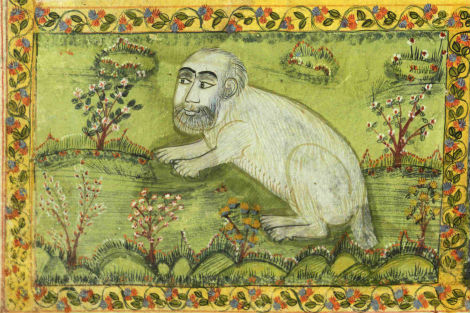 A human-rabbit hybrid (The Book of the Wonders of the Age, 17th- or 18th-century reproduction).
A human-rabbit hybrid (The Book of the Wonders of the Age, 17th- or 18th-century reproduction).
Human × Rabbit or Hare
Mammalian Hybrids
|
I am obliged to report that which is reported, but not to believe it.
—Herodotus, The History, VII, 152
|
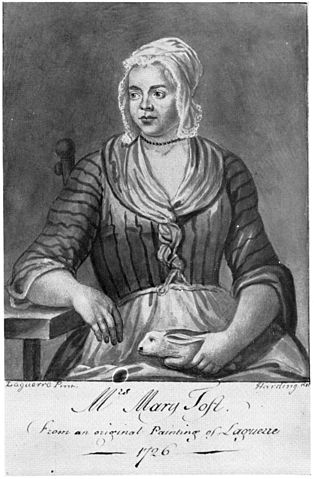 Mary Toft
Mary Toft
Caution! The evidence for this cross is poor.
Historically, there have been various reports about humans hybridizing with rabbits or hares, but this cross is very poorly documented.
At least one such case seems to have been intentionally fabricated. In 1726, an Englishwoman Mary Toft became the center of a national controversy when physician John Howard announced that he had assisted her in giving birth to several rabbits. This claim was eventually exposed as a hoax, but it’s an interesting fact that, at the time, this assertion that a woman could give birth to rabbits was widely accepted by much of the British population.
There have, however, been claims of human-rabbit hybrids, which, although they may have been hoaxes, have not been demonstrated to be such. For example, a report entitled “A Rabbit Baby” appeared on page 2, column 3, of the November 29, 1860, issue of the Centre Democrat, a newspaper published in Bellefonte, Pennsylvania (source), which reads:
Note that the report just quoted gave no personal particulars about the mother or witnesses to this supposed birth—no specific names, no specific addresses—something that makes this report especially unreliable.
Another, equally vague report about a rabbit-human baby appeared on page 3, column 2, of the February 7, 1851, issue of The Athens Post, a newspaper published in Athens, Tennessee (source), which reads:
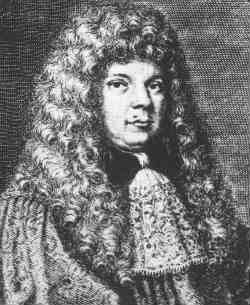 Happel
Happel
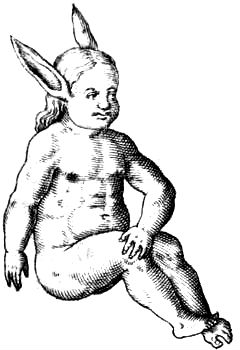 Schenck’s depiction of a supposed rabbit-human hybrid.
Schenck’s depiction of a supposed rabbit-human hybrid.
The incidence of anencephaly seems to be significantly elevated in certain distant hybrid crosses.
The German author Eberhard Werner Happel (Historischer Kern oder so genandte kurtze Chronica, 1690, p. 22) claims that on March 8, 1681 a child with rabbit ears was born at Rotterdam. It supposedly died soon after birth and had a normally formed, viable twin. Happel wrote fiction and nonfiction. His nonfiction works were so voluminous and wide ranging that they were encyclopedic, dealing with almost every conceivable topic.
Similarly, the German physician Johann Georg Schenck von Grafenberg (c. 1560 - 1620) reports (Schenck, 1609, p. 13) that at Königsberg another "child" with rabbits ears was born on Michaelmas (September 30) in 1593 (Königsberg was the former name of modern-day Kaliningrad, Russia).
Hare-human hybrids
The following report appears in the April 17, 1897, issue of the medical journal The Lancet (p. 1128):
Nuremburg, Germany On the basis of a letter from a local pastor, Johann Helwig (1680), a physician residing at that time in Nuremburg, claims that in 1641 a woman gave birth to a “monster having anterior parts like a hare, including the head.” The cadaver, which was that of a male, was mutilated, he says, apparently, in part even flayed (perhaps during delivery?). The ears, too, were mutilated, but one long one like that of a hare extended down over the forehead. The body was short, fleshy and lacked arms and legs, but had a single deformed foot.
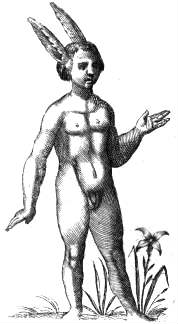 Liceti’s depiction of a hare-human hybrid.
Liceti’s depiction of a hare-human hybrid.
CracowGalileo’s friend, the Italian scientist Fortunio Liceti (1577-1657) mentions (Liceti 1665, p. 186) a hare-human hybrid supposedly born in the year 1440:
Note: Polish renaissance scholar Maciej Miechowita (1457-1523), in his Chronica Polonorum, (1521, p. 358), seems to be the primary source for the Cracow report, since he was living in Cracow at the time in question. The German theologian Christoph Irenäus (1584) refers to a hare-human born in a suburb of Cracow, but says it was harelike with respect to its mouth and neck, and that it was birthed in 1495. He mentions neither ears nor intestines. Whatever this Cracow event may have been, it may have been given a new twist by Polish naturalist Gabriel Rzaczynski (1721, p. 354), who states that a "woman of noble birth," residing in the "Palatinate of Cracow" was given by her husband a hare and a hedgehog as pets. And he goes on to say that she later gave birth to a "prodigious offspring," half hare and half hedgehog.
By the same author: Handbook of Avian Hybrids of the World, Oxford University Press (2006).